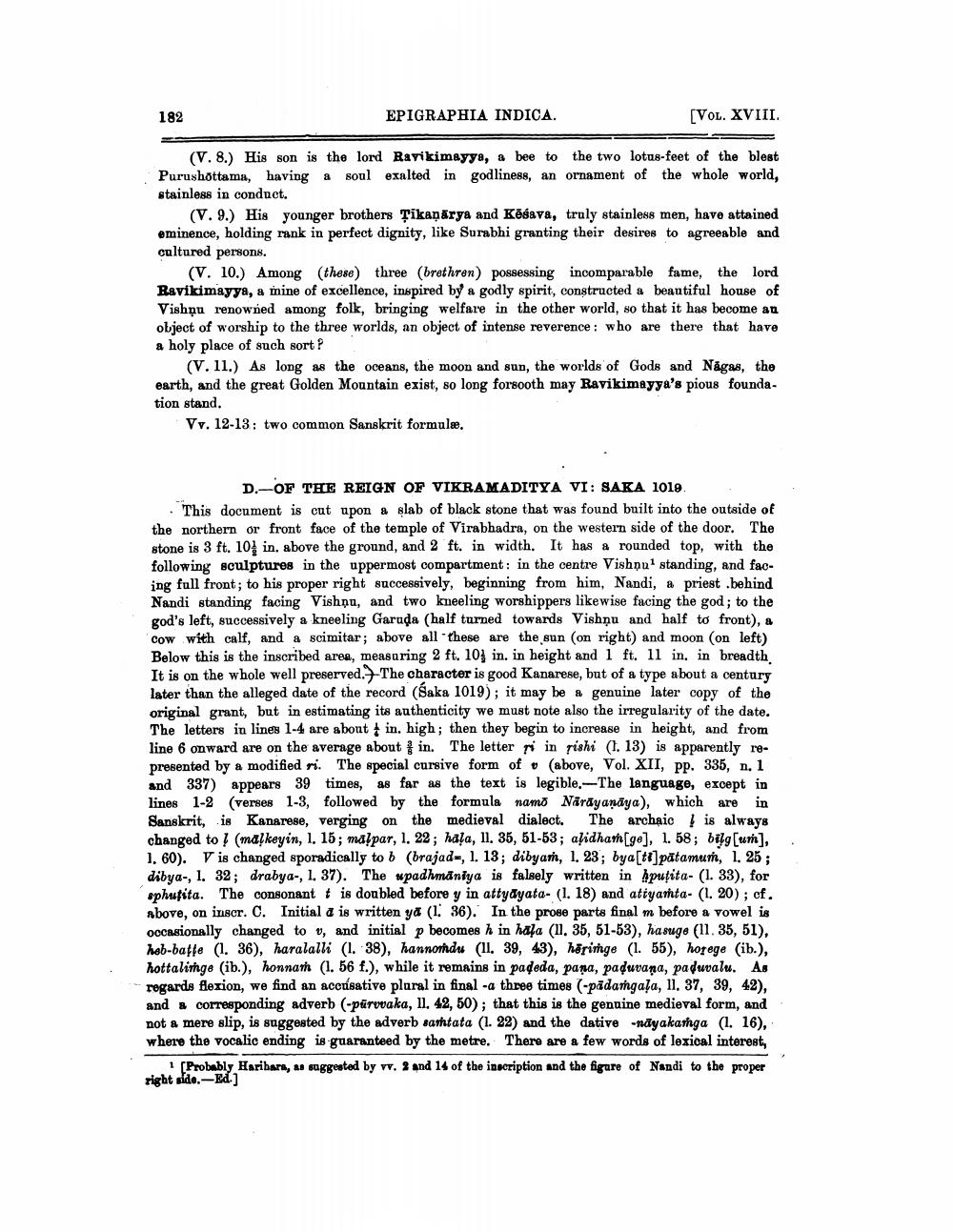________________
182
EPIGRAPHIA INDICA.
(VOL. XVIII
(V. 8.) His son is the lord Ravikimayya, a bee to the two lotus-feet of the blest Purushottama, having a soul exalted in godliness, an ornament of the whole world, stainless in conduct.
(V. 9.) His younger brothers Tikaņārya and Kēšava, truly stainless men, havo attained eminence, holding rank in perfect dignity, like Surabhi granting their desires to agreeable and cultured persons.
(V. 10.) Among these three (brethren) possessing incomparable fame, the lord Ravikimayya, a mine of excellence, inspired by a godly spirit, constructed a beautiful house of Vishņu renowned among folk, bringing welfare in the other world, so that it has become an object of worship to the three worlds, an object of intense reverence: who are there that have a holy place of such sort ?
(V.11.) As long as the oceans, the moon and sun, the worlds of Gods and Nägas, the earth, and the great Golden Mountain exist, so long forsooth may Ravikimayya's pious foundation stand.
Vy. 12-13: two common Sanskrit formulæ.
D.-OF THE REIGN OF VIKRAMADITYA VI: SAKA 1019. . This document is cut upon a slab of black stone that was found built into the outside of the northern or front face of the temple of Virabhadra, on the western side of the door. The stone is 3 ft. 104 in, above the ground, and 2 ft. in width. It has a rounded top, with the following sculptures in the uppermost compartment: in the centre Vishnu' standing, and facing full front; to his proper right successively, beginning from him, Nandi, a priest behind Nandi standing facing Vishnu, and two kneeling worshippers likewise facing the god; to the god's left, successively a kneeling Garuda (half turned towards Vishnu and half to front), a Cow with calf, and a scimitar; above all these are the sun (on right) and moon (on left) Below this is the inscribed area, measuring 2 ft. 101 in. in height and 1 ft. 11 in. in breadth It is on the whole well preserved. The character is good Kanarese, but of a type about a century later than the alleged date of the record (Saka 1019); it may be a genuine later copy of the original grant, but in estimating its authenticity we must note also the irregularity of the date. The letters in lines 1-4 are about in, high; then they begin to increase in height, and from line 6 onward are on the average about in. The letter i in pishi (1. 13) is apparently represented by a modified ri. The special cursive form of • (above, Vol. XII, pp. 335, n. 1 and 337) appears 39 times, as far as the text is legible.-The language, except in lines 1-2 (verses 1-3, followed by the formula namo Närāyanāya), which are in Sanskrit, is Kanarese, verging on the medieval dialect. The archaic I is always changed to 1 (malkeyin, 1. 15; malpar, 1. 22; hala, 11. 35, 51-53; alidham[ge], 1. 58; bila[um]. 1. 60). V is changed sporadically to b (brajads, 1. 13; dibyan, 1. 23; bya[t] patamur, 1. 25; dibya-, 1, 32; drabya-, 1. 37). The wpadhmaniya is falsely written in hpuțita- (1. 33), for sphutita. The consonant t is doubled before y in attydyata- (1. 18) and atiyanta- (1. 20); cf. above, on inscr. C. Initial a is written ya (1. 36). In the prose parts final m before a vowel is occasionally changed to y, and initial p becomes h in hala (11. 35, 51-53), ha suge (11.35, 51). hab-batte (1. 36), haralalli (1. 38), hannodu (II, 39, 43), hēringe (1.55), horege (ib.), hottalinge (ib.), honnan (1. 56 f.), while it remains in padeda, pana, paduvana, paduvalu. As regards flexion, we find an accusative plural in final -a three times (-pādangala, 11. 37, 39, 42), and corresponding adverb (-pūrovaka, 11, 42, 50); that this is the genuine medieval form, and not a mere slip, is suggested by the adverb sattata (1. 22) and the dative ndyakaṁga (1. 16), where the vocalic ending is guaranteed by the metre. There are a few words of lexical interest,
1 (Probably Haribara, as suggested by vv. 9 and 14 of the inscription and the figure of Nandi to the proper right side.-Ed.]




